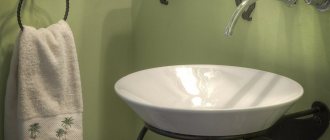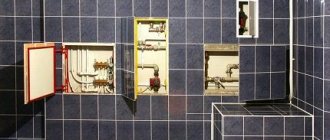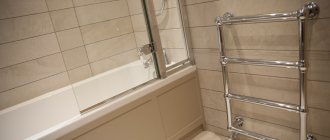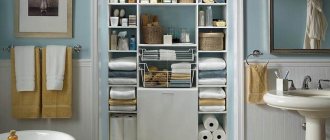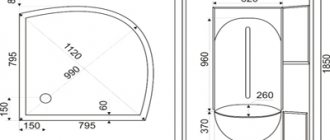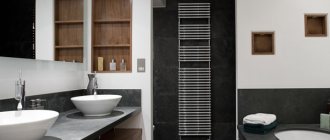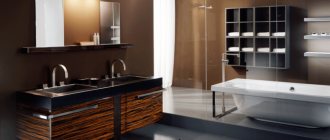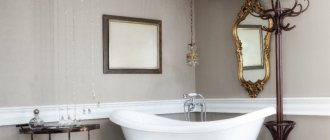Most bathrooms do not have traditional radiators. To heat these wet rooms, special devices are used - heated towel rails. This heating element began to be widely used in Soviet times and continues to do so today.
The purpose of these devices is to dry small laundry (handkerchiefs, panties, etc.), heat and dry towels. At the same time, they also heat the air in the bathroom. This is important, because if there is insufficient heating, the air in the bathroom remains humid for a long time. High humidity is a favorable environment for the development of mold and microbes. In such conditions, wooden furniture begins to rot, and metal parts begin to rust. To prevent the situation from developing, the bathroom should be well heated.
Types of heated towel rails
There are different types of such devices in plumbing stores. They differ in appearance, price, type of coolant, maintenance cost and other characteristics.
Three types of dryers are available:
- Mermen. Connected to the building's hot water supply or heating system. It is most convenient to connect them to the hot water supply. Along with advantages, water appliances also have disadvantages. To connect them to the central heating system, apartment owners will need to obtain permission. In addition, the owners of such devices will have nowhere to dry towels all summer, since the central heating system does not work at this time of year.
- Electrical. Such models are autonomous, their operation does not depend on the season or other factors. To operate an electrical appliance, it is connected to the network. However, these devices also have disadvantages, the main one being the cost of operation.
- Combined. Such models are the most convenient and practical to use. Combined devices operate all year round from several sources - both from the mains and from hot water. The disadvantage is the high cost.
A coolant – hot tap water – constantly circulates inside water models. In multi-storey buildings located within the city, water heated towel rails are connected to the central hot water supply system. If there is no centralized hot water supply in the house, heated towel rails are connected to the heating system.
In electric models, any liquid is used as a coolant, not just water (for example, oil). This liquid is heated by an electric heating element. The devices are equipped with switches, which allows them to be used only at the right time.
Types and features of heated towel rails by heat source
The main classification of heated towel rails is made according to the source through which they operate:
- aquatic. In appearance they resemble curved pipes. They are mainly connected to hot water supply (although they can also be used in a heating system) and provide heating to the surrounding air by passing hot water through them. Such a device can be selected not only by shape (which can be quite varied, but the most popular at present are M- and U-shaped water heated towel rails), but also by color, size and material of manufacture;
- electric. Heating devices that can be installed in any room and, if necessary, can be easily moved to a new location. Electric heated towel rails can have a built-in fan (such models not only dry clothes, but also warm up the room and also reduce humidity in it) or a heating cable, and can also be filled with oil. In addition to mobility, the advantage of such equipment is its compact size, which allows you to remove the device when there is no need to use it;
- combined. Such equipment can operate simultaneously on electricity and with the help of heating and hot water systems. They enable their owner to decide which source of energy will be easier and more profitable for him to use at the moment.
https://youtu.be/ryeiqVJSpLY
What to look for when purchasing?
Which heated towel rail is better - electric, water or combined? It is impossible to answer this question unequivocally. Each has its own pros and cons, so it is advisable to take into account all objective factors.
If the house has an autonomous hot water supply system, it would be optimal to install a water heated towel rail. The only problem is the complicated connection of the device.
If you do not have a hot water supply, then it is better to buy an electric model. The advantage of an electric heated towel rail is ease of installation and the ability to turn the heating on and off at any time. The devices are not connected to the water supply system, so they do not rust or leak. They work regardless of the availability of hot water in the house.
But keep in mind that if you buy an electric model, you must be prepared to constantly pay for electricity costs. Electric units cost much more than water units.
By purchasing a combined device, you can dry towels in the bathroom all year round and not spend extra money on maintenance. During the operation of the central heating system, the device is heated from the hot water supply, and in the summer it is connected to the electrical network.
Shapes of heated towel rails
Unusual design forms of heated towel rails
Choosing heated towel rails for the bathroom only based on the principle of operation is obviously the wrong position; you need to decide on the shape of the structure, volume and take into account the dimensions. And for this you need to have all the information. Absolutely all bathroom heated towel rails can be divided into groups:
Heated towel rail in the bathroom. Choosing between electric and water solutions
- M-shaped. Simple, ordinary dryers that are found in every home. This shape is ideal for heating a room and also plays the role of a compensation loop. A clear advantage of the model is the price. When you find out how much a bathroom coil costs, make sure that this form is the most affordable. The downside is a small selection of designs. This type of drying is suitable for users who prefer simplicity, reliability and comfort.
Advice! When choosing a rotary heated towel rail, look at the connection system (distance between pipes). The fact is that all models are produced according to the same standard and any deviation to the side is not allowed.
- U-shaped heated towel rail. This is a more attractive model that will perfectly complement the bathroom interior. Manufacturers offer a wide range of products, which will allow you to choose the desired shape. The cost of a U-shaped heated towel rail for a bathroom is slightly higher, but this is justified by the design variety of designs.
Important! This model is a non-rotating model and is connected in the case of water heating only with a side connection
Non-standard models for stylish interiors
- The ladder is a very beautiful heated towel rail. The shape is similar to a regular staircase (vertical pillars and horizontal lintels), and the pipes themselves can be either straight or curved in any direction. The price depends on the complexity of the shape, the number of horizontal sections and vertical guides.
- A corner heated towel rail is an ideal solution for small spaces. Installing the model in a corner is extremely simple, and the design takes up so little space that this particular dryer is often used in large bathrooms: several pieces mounted in the corners provide a comfortable temperature throughout the room. Despite its simplicity, the dryer is quite spacious and is often designed in the form of a ladder, with a different number of sections;
- A heated towel rail with a shelf is a beautiful and practical accessory. Most often it is of the water type and is recommended for installation in large rooms. The shelf is useful for drying gloves and shoes. The assortment is varied and offers a choice of models of very different lengths and widths;
- A floor-mounted heated towel rail is another model that will fit well in a small bathroom. The connection is made depending on the type of structure; the advantage is the large capacity and the ability to heat any area;
- Coil – This heated towel rail is the most popular model. When choosing which coil is best for the bathroom, proceed from the area of the room. Too long is recommended for large bathrooms, but for small shapes a coil of one or two turns is suitable. The design is rotatable, which makes its use as convenient as possible.
To see all the variety of shapes and understand how to dry towels in the bathroom on the most fancy dryers, look at the photos presented in the article. It is likely that in the photograph you will be able to find exactly what you need for your bathroom.
Popular forms
- U- or U-shaped. These are the simplest budget devices. Their usable area is small, and not too many things can be placed on them to dry. But such a heated towel rail can easily be placed in place of an old model of a similar shape.
- M-shaped coils. This shape is a little more complicated due to the number of bends. They have an increased usable area and generate more heat. Easy to connect and affordable.
- Ladder. The design consists of horizontally located crossbars - straight or in the form of a “snake”. It has a high price, but you can hang more things on it for drying.
- Complex, non-standard forms. Such models are made to order.
Materials
Heated towel rails are produced from durable stainless steel of different grades. The AISI 304 brand, as well as its analogues, is most often used. There is no plaque deposited on the walls of steel dryers. Models made of stainless steel have a mirror or glossy surface, less often painted.
Plumbing stores sell galvanized steel fixtures. They have a limited service life. These heated towel rails have a painted or chrome-plated surface. They are not suitable for use in conditions of high humidity, typical of bathrooms.
Copper models are quite expensive, but at the same time they are susceptible to the aggressive influence of moisture. They are usually used in vintage interiors.
Ceramic models are made from high-quality ceramics with good heat transfer properties. More often they are used as an element of prestige and luxury.
Aluminum heated towel rails are inferior to their copper and ceramic counterparts in terms of heat transfer coefficient, but surpass them in the number of design ideas.
What materials are heated towel rails made from?
When you decide which type of device is most suitable for your bathroom, you should understand the materials from which modern dryers for wet clothes are made. Such knowledge will help you choose the right heated towel rail.
The cheapest devices are made of ordinary steel. Experts do not recommend installing them in the bathroom, as they are mostly short-lived. This is primarily due to the low quality of water flowing through the pipes. Steel devices come in the following types:
- painted;
- polished;
- chrome plated.
Chrome heated towel rail
Dryers with a chrome surface are considered the most expensive, but also the most durable. Polished structures have a presentable appearance and last a relatively long time. But a painted heated towel rail almost immediately after starting use in the bathroom loses its original appearance. This does not apply to foreign steel products, which are produced with mandatory polymerization of the metal outside and inside the structure. Such devices can be used for decades.
Designs for drying things made from stainless steel are characterized by maximum durability.
If you plan to install a heated towel rail for years to come, you should choose just such a product. And lovers of special aesthetics and originality in the interior of the bathroom can be advised to take a closer look at brass and copper structures. They look great and have a high heat transfer rate. The disadvantage of such products is their relatively low durability (when compared with stainless steel devices).
Heated towel rail in the interior
The bathroom is a rest and relaxation area, so it is important to create a design that is pleasing to the eye. All items in this room must be harmoniously combined with each other and be made in a single stylistic solution. This also applies to the heated towel rail:
- standard models can be used in different interiors - classic and modern;
- original “E”, “P” and “M”-shaped designs look organically in loft, hi-tech, minimalist style;
- painted steel models are harmonious in bathrooms decorated in country style;
- Copper and brass models look ideal in luxurious, rich interiors;
- Designs made of chrome-plated steel go well with high-tech style;
- Appliances made in the form of ladders are suitable for classic interiors.
Equipment and configuration
When choosing a suitable heated towel rail, it is important to pay attention not only to the design and technical characteristics of the device, but also to its configuration. The kit includes a standard fastening system. Typically, manufacturers include in the kit all the parts needed when installing the unit.
The standard kit for installing a heated towel rail includes:
- brackets designed for attaching the device to the wall;
- connecting fittings;
- user manual and product data sheet.
Electrical appliances do not need to be connected to the water supply system, so connecting fittings are not included in the kit.
Additional functions
Electric heated towel rails are multifunctional devices that support a number of additional functions. The presence of these functions makes the devices more convenient and practical to use.
Some models are equipped with a timer function. It ensures that the electrical appliance automatically turns on at a certain time. The presence of this function in the device allows you to warm up the towel by the time you are going to take a bath.
Some models have a thermostat, which makes it possible to maintain their temperature at the desired level. This allows you to set the heating device so that the temperature in the bathroom is constantly maintained at the desired level.
Connection options
There are six connection methods that you should familiarize yourself with before installing the dryer.
Lower
This connection method is rarely used due to the fact that it is not easy to install products using this method. The lower connection is used only if Mayevsky taps are installed in the bathroom. Experts advise using this connection if you need to connect large models.
Right
Sometimes people decide to install vertically elongated drying appliances in the bathroom. It is recommended to connect such devices using the right side method. This connection method is considered universal, as it is suitable for models in the form of ladders and for standard designs.
Left
The left connection is used infrequently, since its implementation requires additional reinforcing fittings. They are installed in at least two places to make the fastening more reliable. The main advantage of this installation is that it saves space in the room.
Diagonal
To improve the circulation of water in the system, it is recommended to use a diagonal connection type. When using this technique, liquid enters from the top and flows down.
It is recommended to use a diagonal connection type when using large ladder-shaped structures.
Upper
Some advise using the top type of connection for heated towel rails. The main advantages of this option include the following:
- independence from the speed of liquid circulation in the riser;
- versatility;
- does not require regular air bleeding.
Angular
The most non-standard installation method is the corner placement of the dryer. In this case, the structure should be placed at a distance of 2-4 centimeters from the riser.

